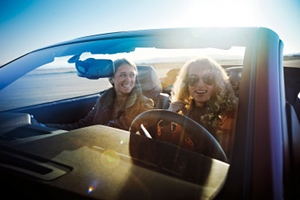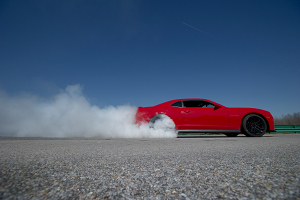Older adults more likely drivers than in past decades
Posted by Elena del Valle on May 9, 2012

Young women drive a Ford Mustang convertible
Photos: Ford, General Motors
Sellers of products or services offline in old style brick and mortar offices and stores, especially those targeting a young demographic, may be interested to know that fewer young people have a driver’s license today than did their counterparts in the early 1980s, according to a University of Michigan study released December 2011. That means young customers without a driver’s license instead of self driving to visit an office or store have to rely on other means such as mass transportation, online shopping, and friends and family who have a car and drive.
The driver’s license study findings seem to match the declining sales of used cars, traditionally bought by young adults, young couples with children at home and married couples with adult children at home (they spend 72 percent more on average*). Average household spending on used cars dropped 30 percent between 2000 and 2007, according to *Best Customers Demographics of Consumer Demand.
While only 22 percent of drivers today are teenagers or in their twenties in 1983, one third of licensed drivers in the country were under 30 years old. That year, more than half of people with driver’s licenses were under 40 years of age and today less than 40 percent of drivers are under 40. The study authors did not analyze information by ethnicity or race.
Emerging market segments are well represented in young demographics. At the same time, Asian, Hispanic and black consumers spend more than the average household on mass transportation and spend less than the average household on transportation in general (Household Spending Who Spends How Much on What).
The researchers in Michigan believe there is a link between the decrease in driver’s license owners and the popularity of texting and electronic devices, activities and products that are popular among young Americans. Emerging market members tend to over index in their consumption of such products and electronic communication methods.

Sports cars like the GM Camaro 2012 may inspire people to get a driver’s license
“It is possible that the availability of virtual contact through electronic means reduces the need for actual contact among young people,” said Michael Sivak, research professor at the U-M Transportation Research Institute. “Furthermore, some young people feel that driving interferes with texting and other electronic communication.”
Sivak and Brandon Schoettle, a University of Michigan Transportation Research Institute colleague, examined the changes from 1983 to 2008 in the percentage of persons with permits to drive by age in a study in the journal Traffic Injury Prevention. They believe that there are fewer young people among all of today’s licensed drivers, and that young drivers are a smaller portion of their age group as a whole, compared to 1983.
That year, 87 percent of 19-year-olds had a permit to drive while in 2008 only 75 percent did. Likewise 80 percent of 18-year-olds had a license in 1983 and only 65 percent had one in 2008; 69 percent of 17-year-olds had a license in 1983 but only 50 percent did in 2008; and 46 percent of 16-year-olds had one in 1983 but only 31 percent did in 2008.
In 2008, people 70 and older were part of the largest group of drivers on the road, representing more than 10 percent of all drivers and a slightly higher percentage than those in their 40s or 50s. By that year licensed drivers as a percentage of their age group population had increased for all groups over 45 years of age since 1983. In 2008, 94 percent of those aged 65 to 69 and 78 percent of those 70 and older had drivers licenses, up from 79 percent and 55 percent, respectively, in 1983.
Some believe the recession, the cost of owning a car, migration trends toward large urban centers and the popularity of social media may account for some of the decline in driver’s permits among young Americans.
Looking internationally Sivak and Schoettle identified a similar pattern of a decrease in young drivers in seven countries and a contrary pattern in another seven countries in a subsequent study released this year, Recent Changes in the Age Composition of Drivers in 15 Countries. They concluded in their analysis that “higher societal wealth, older population in general, and higher proportion of population living in megacities were each associated with higher licensure rates among young persons.” In that study, they found that the more internet users present the lower licensure rates among youth.









